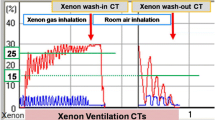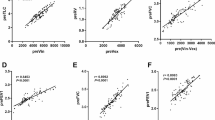Abstract
Purpose
To assess the use of xenon ventilation maps (Xe-images) for predicting postoperative pulmonary function.
Materials and methods
After study approval by the institutional review board, written informed consent was obtained from 30 patients with lung tumors who underwent pre- and postoperative spirometry, pulmonary perfusion SPECT and dual-energy CT (80 kV and 140 kV/Sn) after single-breath inspiration of 35 % xenon. Xe-images were calculated by three-material decomposition. Sum of pixel values of the part to be resected (A) and of the whole lung (B) on Xe-images or lung perfusion SPECT, and volumes or the number of segments of the part to be resected (A) and of the whole lung (B) on Xe-images were enumerated, respectively. We multiplied (1 − A/B) by each preoperative value from spirometry for prediction. Predictions by each of the four methods were compared with postoperative values.
Results
Predicted values for vital capacity (VC), forced vital capacity (FVC) and forced expiratory volume in 1 s (FEV1) by the four methods regressed significantly with measured values (R 2 = 0.56–0.77, p < 0.001 for all).
Conclusion
Analysis of Xe-images can predict postoperative VC, FVC and FEV1 with accuracy comparable to that of CT volumetry.




Similar content being viewed by others
References
Colice GL, Shafazand S, Griffin JP, Keenan R, Bolliger CT. Physiologic evaluation of the patient with lung cancer being considered for resectional surgery: ACCP evidenced-based clinical practice guidelines (2nd edition). Chest. 2007;132:161S–77S.
Mariano-Goulart D, Barbotte E, Basurko C, Comte F, Rossi M. Accuracy and precision of perfusion lung scintigraphy versus 133Xe-radiospirometry for preoperative pulmonary functional assessment of patients with lung cancer. Eur J Nucl Med Mol Imaging. 2006;33:1048–54.
Wernly JA, DeMeester TR, Kirchner PT, Myerowitz PD, Oxford DE, Golomb HM. Clinical value of quantitative ventilation–perfusion lung scans in the surgical management of bronchogenic carcinoma. J Thorac Cardiovasc Surg. 1980;80:535–43.
Hirose Y, Imaeda T, Doi H, Kokubo M, Sakai S, Hirose H. Lung perfusion SPECT in predicting postoperative pulmonary function in lung cancer. Ann Nucl Med. 1993;7:123–6.
Win T, Laroche CM, Groves AM, White C, Wells FC, Ritchie AJ, et al. Use of quantitative lung scintigraphy to predict postoperative pulmonary function in lung cancer patients undergoing lobectomy. Ann Thorac Surg. 2004;78:1215–8.
Kristersson S, Lindell SE, Svanberg L. Prediction of pulmonary function loss due to pneumonectomy using 133Xe-radiospirometry. Chest. 1972;62:694–8.
Ali MK, Mountain CF, Ewer MS, Johnston D, Haynie TP. Predicting loss of pulmonary function after pulmonary resection for bronchogenic carcinoma. Chest. 1980;77:337–42.
Ohno Y, Koyama H, Takenaka D, Nogami M, Kotani Y, Nishimura Y, et al. Coregistered ventilation and perfusion SPECT using krypton-81m and Tc-99m-labeled macroaggregated albumin with multislice CT: utility for prediction of postoperative lung function in non-small cell lung cancer patients. Acad Radiol. 2007;14:830–8.
Yoshimoto K, Nomori H, Mori T, Kobayashi H, Ohba Y, Shibata H, et al. Prediction of pulmonary function after lung lobectomy by subsegments counting, computed tomography, single photon emission computed tomography and computed tomography: a comparative study. Eur J Cardiothorac Surg. 2009;35:408–13.
Wu MT, Pan HB, Chiang AA, Hsu HK, Chang HC, Peng NJ, et al. Prediction of postoperative lung function in patients with lung cancer: comparison of quantitative CT with perfusion scintigraphy. Am J Roentgenol. 2002;178:667–72.
Bolliger CT, Gückel C, Engel H, Stöhr S, Wyser CP, Schoetzau A, et al. Prediction of functional reserves after lung resection: comparison between quantitative computed tomography, scintigraphy, and anatomy. Respiration. 2002;69:482–9.
Caglar M, Kara M, Aksoy T, Kiratli PO, Karabulut E, Dogan R. Is the predicted postoperative FEV1 estimated by planar lung perfusion scintigraphy accurate in patients undergoing pulmonary resection? Comparison of two processing methods. Ann Nucl Med. 2010;24:447–53.
Yamashita CM, Langridge J, Hergott CA, Inculet RI, Malthaner RA, Lefcoe MS, et al. Predicting postoperative FEV1 using spiral computed tomography. Acad Radiol. 2010;17:607–13.
Honda N, Osada H, Watanabe W, Nakayama M, Nishimura K, Krauss B, et al. Imaging of ventilation with dual-energy CT during breath hold after single vital-capacity inspiration of stable xenon. Radiology. 2012;262:262–8.
Wu MT, Chang JM, Chiang AA, Lu JY, Hsu HK, Hsu WH, et al. Use of quantitative CT to predict postoperative lung function in patients with lung cancer. Radiology. 1994;191:257–62.
Zeiher BG, Gross TJ, Kern JA, Lanza LA, Peterson MW. Prediction postoperative pulmonary function in patients undergoing lung resection. Chest. 1995;108:68–72.
Miller MR, Hankinson J, Brusasco V, Burqos F, Casaburi R, Coates A, et al. Standardization of spirometry. Eur Respir J. 2005;26:319–38.
Huda W, Ogden KM, Khorasani MR. Converting dose-length product to effective dose at CT. Radiology. 2008;248:995–1003.
Chae EJ, Seo JB, Goo HW, Kim N, Song KS, Lee SD, et al. Xenon ventilation CT with a dual-energy technique of dual-source CT: initial experience. Radiology. 2008;248:615–24.
Goo HW, Yang DH, Hong SJ, Yu J, Kim BJ, Seo JB, et al. Xenon ventilation CT using dual-source and dual-energy technique in children with bronchiolitis obliterans: correction of xenon and CT density values with pulmonary function test results. Pediatr Radiol. 2010;40:1490–7.
Park EA, Goo JM, Park SJ, Lee HJ, Lee CH, Park CM, et al. Chronic obstructive pulmonary disease: quantitative and visual ventilation pattern analysis at xenon ventilation CT performed by using a dual-energy technique. Radiology. 2010;256:985–97.
Kim JK, Jang SH, Lee JW, Kim DG, Hong KW, Jung KS. Clinical parameters affecting prediction accuracy of postoperative lung function in non-small cell lung cancer. Interact Cardiovasc Thorac Surg. 2008;7:1019–23.
Goddard PR, Nicholson EM, Laszlo G, Watt I. Computed tomography in pulmonary emphysema. Clin Radiol. 1982;33:379–87.
Kinsella M, Müller NL, Abboud RT, Morrison NJ, DyBuncio A. Quantitation of emphysema by computed tomography using a “density mask” program and correlation with pulmonary function tests. Chest. 1990;97:315–21.
Matsuoka S, Kurihara Y, Yagihashi K, Hoshino M, Watanabe N, Nakajima Y. Quantitative assessment of air trapping in chronic obstructive pulmonary disease using inspiratory and expiratory volumetric MDCT. Am J Roentgenol. 2008;190:762–9.
Yamashiro T, Matsuoka S, Bartholmai BJ, San José Estépar R, Ross JC, Diaz A. Collapsibility of lung volume by paired inspiratory and expiratory CT scans: correlations with lung function and mean lung density. Acad Radiol. 2010;17:489–95.
Conflict of interest
The authors declare that they have no conflict of interest.
Author information
Authors and Affiliations
Corresponding author
About this article
Cite this article
Yanagita, H., Honda, N., Nakayama, M. et al. Prediction of postoperative pulmonary function: preliminary comparison of single-breath dual-energy xenon CT with three conventional methods. Jpn J Radiol 31, 377–385 (2013). https://doi.org/10.1007/s11604-013-0202-z
Received:
Accepted:
Published:
Issue Date:
DOI: https://doi.org/10.1007/s11604-013-0202-z




